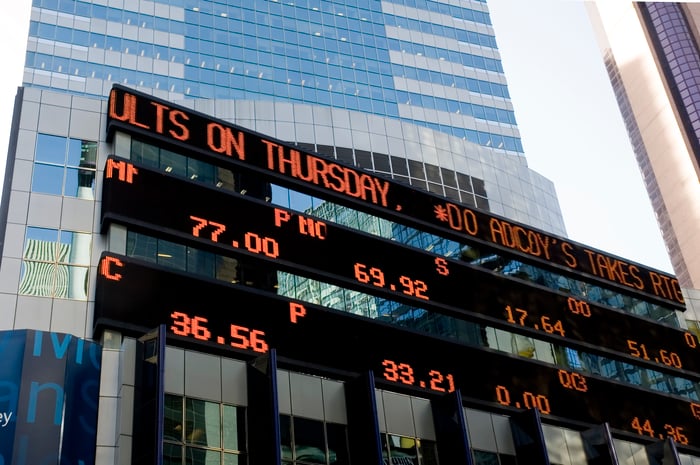You probably don't need the reminder, but it's been a rough year for the investing community. The bond market is enduring its worst year on record, while the growth-dependent Nasdaq Composite, which led the broader market higher for much of the past decade, has plunged as much as 38% over the trailing year.
Yet amid this carnage, the 30-component Dow Jones Industrial Average (^DJI -0.11%) has performed reasonably well. Through last week, the Dow was lower by just 5.5% year to date. That's a testament to the quality of companies that make up the Dow Jones Industrial Average.

Image source: Getty Images.
But just because the index hasn't plunged as much as the Nasdaq Composite and S&P 500 doesn't mean there aren't amazing deals hiding in plain sight. Here are three Dow stocks that make for phenomenal end-of-year buys.
Walt Disney
The first Dow Jones Industrial Average stock that makes for a stellar end-of-year buy is media giant Walt Disney (DIS 0.18%).
The normally sure-footed House of Mouse has been highly prone to slip-ups since the COVID-19 pandemic began. In addition to reduced attendance at its theme parks, Disney is dealing with lower movie theater attendance. The icing on the cake is that streaming service losses have come in wider than expected, at a time when investors have been more critical of bottom-line results than at any point over the past decade.
But if Walt Disney has demonstrated anything over many decades, it's that the company is resilient. This is due to a multitude of competitive advantages.
For example, few companies have the ability to engage with consumers quite like Walt Disney. Whether it's a 4-year-old visiting Disneyland for the first time or a grandparent watching a Disney movie with their grandchild, the company's products, services, and characters are designed to connect people of all ages through the use of imagination.
This leads to another key point: Walt Disney has superior pricing power. Since Disneyland opened in Southern California in 1955, the price of the cheapest admission ticket has climbed 10,300%! Comparatively, that's about 10 times the rate of inflation in the U.S. since 1955. People have shown for nearly seven decades that they're willing to pay a premium for the experience Disney can offer them, their family, and their friends.
The company's streaming segment can also become a key growth driver by mid-decade. Despite large near-term losses tied to its expansion, Disney+ has tallied more than 164 million subscribers in less than three years after its launch. According to the company, streaming services should become profitable by 2024.
Though Walt Disney's stock has taken a beating this year, it's given patient investors a dream entry point.
Intel
The second Dow stock that represents a phenomenal end-of-year buy is semiconductor stock Intel (INTC 0.64%).
Shares of Intel have declined by more than 50% since early 2020 because of two concerns. First, the company has been losing central processing unit (CPU) market share in personal computers (PCs), mobile, and data center servers to key rival Advanced Micro Devices. Secondly, Intel is a cyclical company. A weaker U.S. growth outlook, coupled with supply chain issues and historically high inflation, is generally bad news for its revenue and profit outlook.
While there's no doubt Intel is facing some very tangible near-term headwinds, the company has positioned its puzzle pieces for long-term success.
For example, Intel broke ground on two chip manufacturing plants in Ohio earlier this year. This $20 billion project, set to begin production in 2024, is designed to expand Intel's Foundry Services segment. Best of all, with President Joe Biden signing the CHIPS and Science Act into law in August, nearly $53 billion in subsidies are now available to aid with the construction of domestic chip manufacturing sites.
Pessimists have also, arguably, made a mountain out of a molehill when it comes to Intel's lost CPU market share. While no lost market share should be taken for granted, Intel is still very much in the driver's seat in PCs, mobile, and data center servers. The cash flow being generated from these arenas is what's helping to fuel the company's superior dividend (5% yield), as well as its investments in higher-growth initiatives.
One of the more exciting opportunities for Intel is the growth of autonomous vehicle company Mobileye Global. Intel acquired Mobileye for $15.3 billion in 2017 and remains the majority shareholder following Mobileye's initial public offering in late October. Mobileye has been generating record sales, with annual run-rate revenue now up to $1.8 billion.
For long-term investors, Intel offers an exceptional risk-to-reward at its current share price.

Image source: Getty Images.
Salesforce
The third and final Dow stock that makes for a phenomenal end-of-year buy is cloud-based customer relationship management (CRM) software provider Salesforce (CRM -0.18%). CRM software is used by consumer-facing businesses to improve existing client engagement and boost sales.
Like the other Dow components on this list, Salesforce stock has been bludgeoned in 2022. Shares are down 40%, which is considerably worse than the noted (5.5%) year-to-date return for the Dow Jones Industrial Average. This weakness can primarily be blamed on the U.S. economy and hawkish monetary policy. The growing likelihood of a recession, coupled with the removal of cheap capital as interest rates rise, probably means Salesforce will see a slowdown in demand for its CRM software.
Of course, Salesforce wouldn't be on this list if it didn't possess clearly identifiable competitive advantages that can sustain double-digit growth and make its patient shareholders richer over time.
The first thing to note about Salesforce is just how dominant it's become in the CRM space. Not only has the company been the No. 1 ranked global CRM software provider for the past nine years, according to IDC, but it's been steadily expanding its industry-leading market share for pretty much the entire time. It ended 2021 having accounted for 23.8% of global CRM spending. That's more than its four closest competitors on a combined basis.
To build on this point, CRM software is a sustained double-digit growth opportunity. Though service-oriented companies are the most logical customer, we're seeing increasing usage of CRM software from the industrial, financial, and healthcare sectors. Translation: Salesforce has a hearty organic growth opportunity on its plate.
On top of steady organic growth, co-founder and co-CEO Marc Benioff has helped orchestrate a number of key acquisitions. Some of the best-known deals include Tableau Software, MuleSoft, and Slack Technologies. Although these deals provide new revenue channels for the company, it's really about expanding the Salesforce service ecosystem and adding cross-selling opportunities.
With its share price taking a serious haircut, Salesforce looks like a bargain for growth-oriented investors at approximately 27 times Wall Street's forecast earnings for fiscal 2024.





